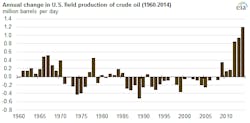EIA: US oil output growth in 2014 largest in more than 100 years
US crude oil production, including lease condensate, increased during 2014 by 1.2 million b/d to 8.7 million b/d, the largest rise in volume since recordkeeping began in 1900, according to data from the US Energy Information Administration.
Output during the year increased 16.2%, the highest growth rate since 1940, mostly coming from tight oil plays in North Dakota, Texas, and New Mexico where hydraulic fracturing and horizontal drilling were used to produce oil from shale.
EIA notes that “annual increases in crude oil production regularly surpassed 15% in the first half of the 20th century, but those changes were relatively less in absolute terms because production levels were much lower than they are now.”
Crude production in the US has increased in each of the previous six years. From 1985 to 2008, production fell in every year except one.
The American Petroleum Institute this month reported that US crude production in February increased 14.5% year-to-year to a nearly 9.3 million b/d average, its highest level since April 1973 (OGJ Online, Mar. 20, 2015).
Although oil production is expected to rise in 2015 and again in 2016, the growth is not expected to be as strong as in 2014 due to the fall in crude oil prices. Annual production is expected to grow at a slower rate, 8.1% this year and just 1.5% next year, according to EIA's latest Short-Term Energy Outlook (OGJ Online, Mar. 10, 2015).
EIA says the slowdown in growth is more evident when looking at production between December 2014 and December 2015, which is forecast to rise by just 200,000 b/d.
In its most recent Drilling Productivity Report, EIA said it expects growth from the Eagle Ford and Bakken shales to decline in April while production continues to grow in the Permian (OGJ Online, Mar. 10, 2015).

